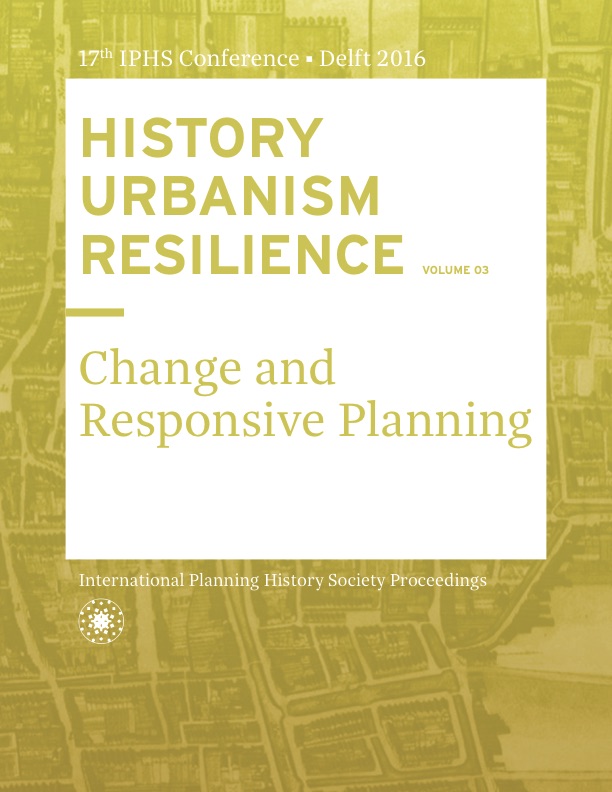City Resilience amid the Modern Urban Warfare: the case of Nablus/ Palestine
DOI:
https://doi.org/10.7480/iphs.2016.3.1275Abstract
Cities across the globe are increasingly becoming the main theater of modern warfare. Reviewing the 15 largest conflicts in the world in which International Committee of the Red Cross is active today, the most remarkable sites that emerge are urban centers. Cities like Gaza, Aleppo, Donetsk and Aden are enduring the hardest consequences of prolonged conflicts that transform the spaces of the everyday life into scenes of confrontation with the most existential challenge: survival (Chonghaile, 2015).Wars in the middles demonstrate that the State is no longer defending its cities by its National Army; instead, the State is defended city by city and street by street through decentralized armed groups of regular armies, militia, mercenaries and armed civilians. Homes, markets, civic buildings and even hospitals are not only shelled from distance, but are also transformed into ‘miniature’ battlefields. This transformation of modern warfare from regular armies in open battlefields into paramilitary groups penetrating in and distorting urban fabrics raises the question over the resilience of the contemporary city.
With the increasing chaos of urban warfare, and the profound escalation of risks and costs of humanitarian aid, this paper aims to pay attention to the city and its tangible and intangible structures. It hypothesizes that the interplay between urban form and social norms (P. Rabinow, 1995 ) has a profound impact on the city’s resilience. By taking the case of Nablus- Palestine, the paper conducts a comparison between two urban fabrics that compose the city: the old town and the modern neighborhoods. For the last 15 years, Nablus has experienced diverse waves of violence ranging from night attacks, curfews to total invasion of 2002: during these events, residents of the city acquired experience and developed several resilience practices that vary according to the differences in the social and urban structures. This analytical comparison will provide better understanding of the relationship between the urban from and culture on the one side and resilience on the other side. The study of the accumulation of these experiences not only unfolds the inventiveness that extreme conditions catalyzes, but highlights the fundamental impact of spatial conditions on possible survival strategies. Isn’t survival the zero degree of resilience? In that sense, these accumulated experiences are an essential resource for any further physical and social planning of the city.
Modernity has overlooked the urban warfare, and modern urban planning does not address its probability. The WWII tactics of defending urban centers mainly focus on the external threats but not on the possible internal ones. However, nowadays, threat is coming from within including civil wars and terrorism. Modern warfare not only threatens cities in the Middle East, Africa and Latin America: terrorism demonstrates an internal menace that threatens the global city. The aftermath of the terror attacks on Paris and the emergency condition taken in Brussels afterward, have shown a sort of fragility in the preparedness of modern cities to confront the state of exception that more and more and on more and more places becomes the regular state.
References
Abujidi , Nurhan , and Han Verschure. “Military Occupation as Urbicide by “Construction and Destruction”: The Case of Nablus, Palestine.” The Arab World Geographer 9 (2) (2006): 126–154.
Bleibleh, Thaera, Architectural Reading of the Ottoman’s Sijills of the Ll-Shar’yah Court in Nablus City between 1655-1807 (unpublished master thesis, 2010)
Chonghaile, Clár Ní. “Urban warfare has altered the nature of humanitarian work.” The Guardian (2015). Accessed Dec 30, 2015. http://www.theguardian.com/global-development/2015/nov/13/urban-warfare-humanitarian-work-international-committee-red-cross-peter-maurer-cities-conflict.
DiMarco, Lou. “Attacking the Heart and Guts: Urban Operations through the Ages.” Urban Operations: An Historical Casebook. Kansas : Combat Studies Institute (2002). Accessed Jan 2014. http://www.globalsecurity.org/military/library/report/2002/urbanoperationsintro.htm.
Evans, Michael. 2007. City Without Joy: Urban Military Operations into the 21st Century. Canberra: Australian Defence College.
Graham, Stephen. “Cities, War, and Terrorism, Towards an Urban Geopolitics.” Blackwell Publishing, 2004.
Graham, Stephen. “The Urban ‘Battlespace’.” Theory, Culture & Society.” SAGE 26 (2009): 278-288.
Kafala, Tarik. “The high cost of urban warfare.” BBC (2003). Accessed Dec 30, 2015. http://news.bbc.co.uk/2/hi/middle_east/2882295.stm.
Khamaisi, Rasem. “Structural Plans as a Mean of Local Development for Palestinian Government”, Al-Syasah Al-Filistiniyah, No. I and II, (1994):65-91 (in Arabic).
Loeckx, André. “Kabylia, the House, and the Road: Games of Reversal and Displacement.” Journal of Architectural Education 52 (2) (1998): 87–99.
Purvis, Katherine. “Delivering aid: agencies struggle with increasing needs, costs and insecurity.” The Guardian (2015). Accessed 31 Dec, 2015. http://www.theguardian.com/global-development-professionals-network/2015/dec/16/delivering-humanitarian-aid-increasing-needs-costs-insecurity-conflict-.
Weizman, Eyal. “Hollow Land, Israeli Architecture of Occupation.” London: Verso 2007.
Weizman, Eyal. “Walking Through Walls.” eipcp (2007). Accessed 2016. http://eipcp.net/transversal/0507/weizman/en.

